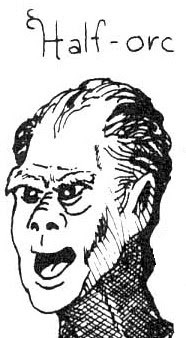Half-Orcs Were a Mistake
 Wanted: For the Crime of
Wanted: For the Crime of Gygaxian Naturalism
Despite Gary Gygax's repeated assertion that his conception of Dungeons & Dragons owes little to the works of J.R.R. Tolkien's The Lord of the Rings (which he nevertheless included in Appendix N), he sure did borrow a lot of individual elements from the novel! Orcs are regularly cited as the prime example of this peculiar phenomenon and rightly so, I think, because, as a distinct type of enemy, they are largely without any significant mythological precedent prior to the publication of Tolkien's tales. At the same time, orcs are, at base, little more than man-shaped monsters in service to Evil, not unlike similar creatures found in northern European folklore and in the pulp fantasy stories that proliferated in the first half of last century.
The same, however, cannot be said for the half-orc, references to which can also be found in The Lord of the Rings. The precise nature of half-orcs in Middle-earth is unclear, partly because I don't believe Tolkien ever settled the question of the nature of orcs, having changed his mind several times on the subject. What we can say for certain is that Tolkien's half-orcs – or "goblin-men," as he sometimes called them – were creatures that, while generally orcish, looked enough like Men that they move among them without attracting much comment. Half-orcs were thus useful as spies by the forces of Evil.
Half-orcs don't exist in Dungeons & Dragons prior to the publication of the AD&D Monster Manual in 1977, where there's a brief discussion of them at the end of the book's entry for "orc." There, Gygax states that
As orcs will breed with anything, there are any number of unsavory mongrels with orcish blood, particularly orc-goblins, orc-hobgoblins, and orc-humans. Orcs cannot cross-breed with elves. Half-orcs tend to favor the orcish strain heavily, so such sorts are basically orcs although they can sometimes (10%) pass themselves off as true creatures of their other stock (goblins, hobgoblins, humans, etc.).
This sounds a lot like the broos of Glorantha, does it not? In any case, the Players Handbook a year later gives us a a bit more information about them. Here, Gygax reiterates that
Orcs are fecund and create many cross-breeds, most of the offspring of such being typically orcish. However, some one-tenth of orc-human mongrels are sufficiently non-orcish to pass for human.
The remainder of the PHB's description is given over to game mechanics, with little else stated about the nature of half-orcs or the place within the implied setting of AD&D. We do learn that, with the exception of humans and halflings (!), all other playable races hate or have antipathy for half-orcs. This makes sense, given half-orcs' preference for classes like thief and assassin, marking them as having criminal and antisocial tendencies of a most unsavory sort. I have no idea why Gygax felt the need to include orc-human hybrids as a playable race in AD&D, though I suspect that, like half-elves, which first appeared in Supplement I to OD&D, he did so to appeal to the fans of The Lord of the Rings among early gamers. I think this was a profound mistake, one that has haunted D&D ever since.
I say this because orcs are monsters. According to the Monster Manual, they "are cruel and hate living things in general." Likewise, "they take slaves for work, food, and entertainment (torture, etc.)." They're not people in the same sense that, say, humans, dwarves, or elves are – or at least that's how I think they were initially conceived. Unfortunately, Gygaxian naturalism upended that particular apple cart and we discovered that orc lairs contain noncombatant females and young. No longer is an expedition into the Caves of Chaos a simple matter of defending the Realm against Evil; now it's an exercise in the mass murder of the defenseless.
The existence of playable half-orcs only complicates the matter further. It might just be possible to squint one's eyes and imagine that even baby orcs are an existential threat to the Realm of Law and Goodness and therefore fit only for extermination. Once you allow playable orc-human hybrid characters who are not required by the rules to evil, let alone restricted from being good, you open the door to viewing orcs (and, by extension, all humanoid monsters) as people on par with the more traditional player character races. From there, you're well on the road out of the adventuresome pulp fantasy world D&D has long evoked and heading toward … something else entirely.
Far be it for me to suggest that there's anything inherently wrong with this approach to fantasy. Indeed, there might well be something genuinely fun and compelling about treating humanoid races as one might treat alien species in an episode of Star Trek rather than as ravening Chaos-spawn that bubble up from the black blood of the Earth to wreak havoc across the Realm of Man. However, for those of us who like fighting orcs (and goblins and gnolls and …) without pangs of conscience, I think it's important we keep them genuinely monstrous and inhuman. Doing this necessitates, among other things, abandoning the idea of playable half-orcs. They were a grave mistake back in 1978 and they've only become more so in the more than four decades since.
James Maliszewski's Blog
- James Maliszewski's profile
- 3 followers



